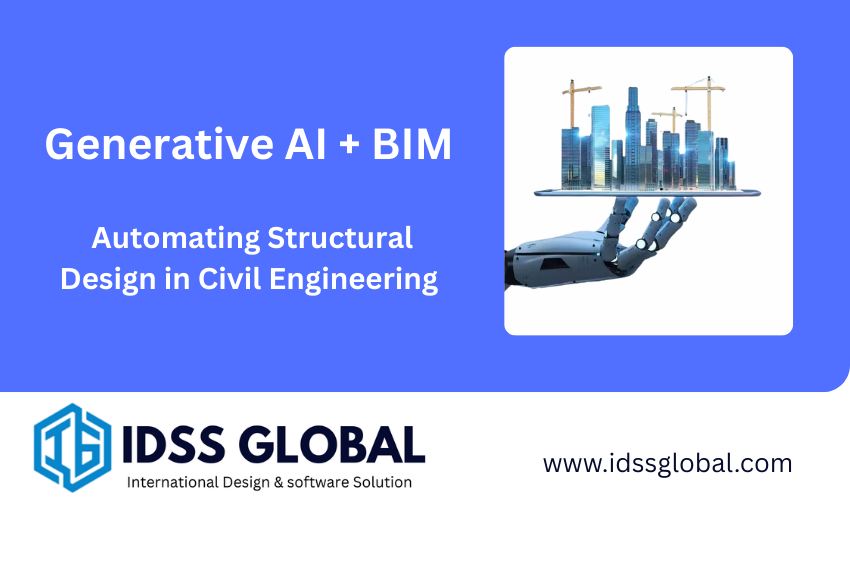The civil engineering industry is standing at a turning point. As cities grow denser, projects get more complex, and clients demand faster, greener solutions, the pressure on design teams has never been higher. While Building Information Modeling (BIM) has already transformed the way engineers and architects collaborate, the rise of Generative Artificial Intelligence (AI) is pushing civil design into a new era: automated, intelligent, and performance-driven structural design.
Generative AI—an advanced form of AI capable of creating designs, models, and simulations—when integrated with BIM, opens new possibilities for how we plan, design, and optimize civil structures. From bridges and highways to skyscrapers and water systems, AI-assisted BIM workflows are enabling smarter, safer, and more sustainable infrastructure.
In this blog, we’ll explore how Generative AI and BIM are converging, their real-world applications, benefits, challenges, and what the future holds for civil engineers.
1. What is Generative AI in Civil Engineering?
Generative AI is not just about chatbots or text generation—it refers to AI systems that can create new content or solutions based on large datasets and rules. In the civil design world, this means AI models that can:
- Generate multiple structural design options automatically
- Optimize layouts for cost, material efficiency, and sustainability
- Simulate different load conditions, climate factors, and safety scenarios
- Suggest the “best fit” design based on project requirements
Unlike traditional design tools, generative AI doesn’t just follow inputs—it learns from past projects and real-world data to propose innovative yet practical solutions.
2. BIM as the Foundation of Intelligent Design
Building Information Modeling (BIM) has become the digital backbone of modern construction projects. BIM models are not just 3D drawings; they are data-rich environments containing information about:
- Materials and structural properties
- Energy efficiency and sustainability factors
- Construction schedules and cost estimates
- Lifecycle management and maintenance needs
This makes BIM an ideal partner for AI. With BIM’s structured data and generative AI’s predictive power, engineers can move from manual, trial-and-error design to automated, optimized, and real-time solutions.
3. How Generative AI + BIM Automates Structural Design
When integrated, generative AI and BIM create a closed loop of design, evaluation, and optimization. Here’s how:
a) Automated Concept Generation
Instead of drafting multiple design options manually, engineers can input constraints (budget, material type, load capacity, site limitations). AI then generates dozens of potential models within BIM—each meeting the baseline requirements.
b) Structural Optimization
The AI runs simulations on factors like wind load, earthquake resistance, and soil conditions, narrowing down the designs to the safest and most efficient options.
c) Sustainability Analysis
Generative AI cross-checks material usage, carbon footprint, and energy efficiency within the BIM model, ensuring compliance with green building standards.
d) Clash Detection & Error Reduction
AI-enhanced BIM can identify potential clashes between structural, MEP (Mechanical, Electrical, Plumbing), and architectural elements far earlier than human review.
e) Continuous Learning
As more projects are completed, the AI system learns and improves its design suggestions, making future projects faster and more reliable.
4. Real-World Applications
Generative AI and BIM integration is already making waves in civil projects:
- Bridge Design: AI can simulate thousands of structural forms and load-bearing designs, reducing design cycles from months to weeks.
- High-Rise Buildings: AI models help optimize column placements, floor loads, and energy use.
- Urban Infrastructure: Smart road networks and drainage systems designed with AI-BIM integration adapt better to climate change and urban growth.
- Water Systems: AI predicts demand fluctuations and integrates this into BIM models for more efficient water distribution systems.
5. Benefits for Civil Engineering Firms
The integration brings measurable advantages:
- Speed: Automated design cuts weeks off the design cycle.
- Cost Savings: Optimized designs use less material without compromising safety.
- Risk Reduction: AI-driven clash detection minimizes costly rework during construction.
- Innovation: Firms can explore designs that may not have been humanly conceived.
- Sustainability: Reduced carbon footprint through material and energy efficiency.
6. Challenges & Limitations
As with any disruptive technology, there are hurdles:
- Data Quality: Poor BIM data limits AI’s effectiveness.
- Adoption Barriers: Engineers and contractors may resist relying too heavily on automation.
- Standardization: Lack of global standards for AI-BIM workflows.
- Ethical & Liability Issues: If an AI-generated design fails, who is responsible—the engineer or the algorithm?
- Computational Power: Generative AI requires high processing capabilities and investment.
7. The Future of AI + BIM in Civil Design
Despite challenges, the trajectory is clear: AI + BIM will become the new standard in structural design. We can expect:
- Generative Design as a Service (GDaaS): Cloud-based platforms offering AI-generated design solutions.
- Integration with Digital Twins: Linking AI-BIM models with real-time sensor data to predict maintenance needs.
- Global Collaboration: AI platforms allowing cross-border design optimization and knowledge sharing.
- Regulatory Adoption: Governments incorporating AI-driven BIM submissions into approval processes.
Civil engineers will not be replaced—but empowered. Instead of spending weeks drafting and revising, they will focus on decision-making, creativity, and sustainability goals while AI handles the heavy lifting.
Conclusion
Generative AI and BIM together represent a paradigm shift in civil engineering design. The ability to automate structural solutions, optimize for sustainability, and reduce errors is not just a productivity boost—it’s a survival strategy for firms in an increasingly competitive and sustainability-driven market.
By embracing AI-BIM integration, civil engineers are not only designing structures—they are designing the future of infrastructure itself.


